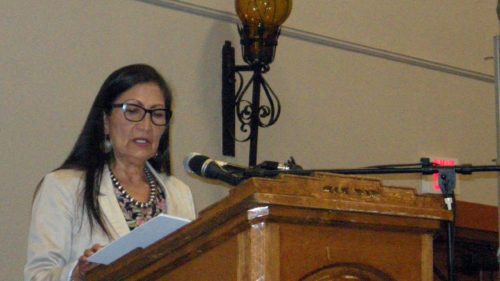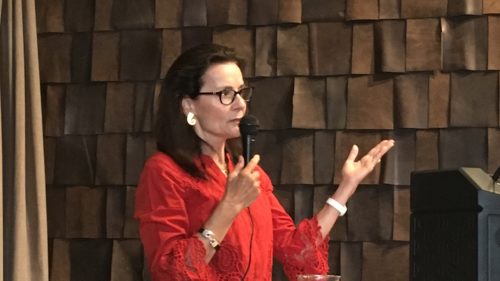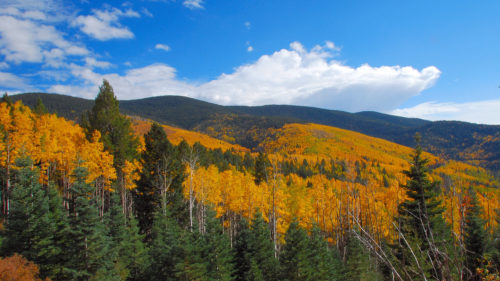By BEN NEARY
NMWF Conservation Director
ALBUQUERQUE _ A federal judge intends to rule by the end of the summer on Jemez Pueblo’s claim that it owns the nearly 90,000-acre Valles Caldera National Preserve.
Jemez Pueblo claims its aboriginal property rights to the area were never extinguished even though the federal government declared the area to be vacant land in 1860 and transferred it to private ownership.
The federal government disputes the pueblo’s assertion it still has rights to the area.
At stake is the sprawling Valles Caldera, a collapsed volcanic dome in the heart of the Jemez Mountains. In addition to spectacular scenery, it offers world-class trout fishing and holds a trophy elk herd. As a national preserve, it’s an important recreation and tourism destination.
To the people of Jemez Pueblo, however, the land has critical religious importance. They say they’ve continued to use it for ceremonies, for hunting and as a place to gather necessary religious items up through the present day.
Former Jemez Pueblo Gov. David Joshua Madalena gave a statement in support of the pueblo’s legal claim in late 2017. He said the Jemez people refer to the area not as the Valles Caldera but as Redondo Wavema.
“It is our holy land,” Madalena said. “It is as important as the Vatican is important to Catholic. Blue Lake is to the Taos. We preserve it as the best way we can and not to destroy it in any way.”
The federal government in 1860 granted the land to the heirs of Luis Maria Cabeza de Baca as partial settlement for a property dispute elsewhere. It passed through various private hands over the next 140 years before the Dunigan family of Abilene, Texas, sold it to the federal government for $101 million in 2000.
Money for the purchase came from the federal Land and Water Conservation Fund, which collects revenues from offshore energy production. The ranch purchase took years of effort from conservationists in the state, notably including former New Mexico Game and Fish Department Director Bill Huey.
Although the Dunigans provided the government with a warranty deed, they specified they weren’t warranting the property against Indian claims.
U.S. District Judge James Browning presided over a trial last fall on Jemez Pueblo’s claims. The trial lasted several weeks in Albuquerque.
Browning heard final arguments from lawyers representing Jemez Pueblo and the U.S. Department of Justice, which opposes the pueblo’s claims, on May 7. The judge said at that hearing that he intends to release his ruling on the case by late summer.
The case came to Browning after the U.S. 10th Circuit Court of Appeals in Denver in 2015 overruled a 2013 decision by U.S. District Judge Robert Brack.
Brack had dismissed Jemez Pueblo’s claims to the land. He said the pueblo missed its chance to sue the federal government when it failed to do so within five years of the 1946 passage of the Indian Claims Commission Act.
However, the three-judge panel of the 10th Circuit Court of Appeals ruled that, because the government’s 1860 transfer of the land to the Baca heirs didn’t necessarily extinguish the pueblo’s aboriginal title, it didn’t create a pre-1946 claim for loss of that title that had to be filed within the five-year window.
Jemez Pueblo maintains that its claim against the federal government didn’t begin until 2000, when the federal government acquired the land from the Dunigans and, the pueblo says, began interfering with the pueblo’s use of it.
Lawyers for the federal government had asked Browning to dismiss the pueblo’s case without going to trial, a request the judge denied.
In denying the federal government’s request to dismiss the pueblo’s claims, Browning wrote that, based on the nature of “aboriginal occupancy,” he wasn’t convinced that the government had taken away the pueblo’s property right between 1860 and 2000.
Browning also ruled that even if other tribes used the Valles Caldera, that wouldn’t necessarily defeat Jemez Pueblo’s claim to aboriginal title.
At a hearing in September, lawyer Peter Dykema of the U.S. Department of Justice’s Environment and Natural Resources Division in Washington, D.C., argued to Browning that the pueblo’s argument was “at war with common sense.”
“Plaintiff’s argument implies that if aboriginal title existed in the year 1848, when the United States acquired sovereignty, and Congress has not, in so many words, extinguished it, then aboriginal title continues even if other tribes occupied the land to plaintiff’s exclusion, even if plaintiff ceased all use, even if private owners to whom Congress gave the land put up a fence and precluded all use by the plaintiff for 150 years,” Dykema said. “Plaintiff’s argument doesn’t make sense.”
Reached by telephone on Friday, Dykema declined comment on the case.
Lawyer Justin Solimon, representing Jemez Pueblo, filed papers with Browning in April presenting the facts and legal conclusions the pueblo would like to see the judge accept in his final opinion.
In that filing, Solimon emphasized that Jemez Pueblo’s rights to the area pre-existed and survived both Spanish and Mexican rule of the area and continue to survive under United States rule.
“The Pueblo of Jemez does not have to allege that the Baca heirs and their successors were not using the land so long as the pueblo alleged that it was using the land in traditional ways,” Solimon wrote.
After the federal government acquired the land from the Dunigan family, it sold about 5,000 acres of the land to Santa Clara Pueblo for $4.5 million to protect the headwaters of that pueblo’s water supply.
“The Santa Clara acquisition of its aboriginal Indian title lands within the Baca Ranch confirms the plaintiff’s assertion that the balance of the Valles Caldera National Park belongs to Jemez Pueblo pursuant to its aboriginal Indian title,” Solimon wrote.
An attempt to reach Solimon for comment on Friday wasn’t immediately successful.



